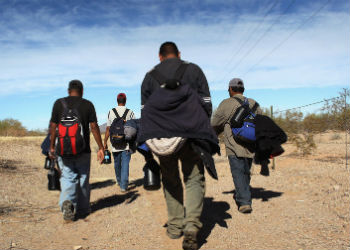A recent study from a pair of academics specializing on border issues finds a wide degree of overlap between coyotes and drug traffickers along the US-Mexico border, with government policies helping to encourage the blurring of the lines between the two illicit activities.
The 2016 paper “On Narco-coyotaje: Illicit Regimes and Their Impacts on the US-Mexico Border,” by Howard Campbell and Jeremy Slack, probes the dynamics along the Mexican border between human traffickers, or coyotes, and their criminal cousins who traffic drugs.
Based largely on interviews with migrants in Tamaulipas, Sonora, and Baja California, the authors’ basic finding is that where once coyotes and drug traffickers operated in separate spheres, today there is a great deal of collaborative overlap. According to Campbell and Slack, who teach at the University of Texas-El Paso, this evolution essentially coincides with the growth of “a criminal hierarchy prioritizing the most powerful and profitable clandestine activity…drug trafficking”.
But while drug traffickers have exerted increased authority over coyotes in recent years, the circumstances of this hierarchy vary greatly from one part of the country to the other. In Tamaulipas, for instance, the coyotes essentially worked at the pleasure of the dominant local groups — either the Zetas and the Gulf Cartel, depending on the city. In practice, this means the coyotes would make protection payments and would operate according to a detailed set of rules established by the drug gangs about how coyotes must operate. Migrants would often be obligated to provide occasional monitoring services for shipments of drugs. Migrants and coyotes who broke with the dictates would be punished, often beaten and kidnapped.
SEE ALSO: Coverage of Human Smuggling
In other parts of the country, such as the Sonora Desert, dominant local drug gangs (typically affiliated with the Sinaloa Cartel) exercise much less immediate control. The authors describe local gangs as protecting human trafficking markets from stick-up artists targeting cash-rich migrants, occasionally using migrant groups to tote drug stashes across the border, and preventing them from walking where they don’t want to draw the attention of the US Border Patrol. More recently, a local gang set up a checkpoint on the road from Altar, Sonora, to the border, in which migrants were charged a fee for passage.
InSight Crime Analysis
Slack and Campbell describe a high degree of fluidity in the interactions between coyotes and drug traffickers. Most coyotes have a clear incentive to have at least some relationship with the drug traffickers, even beyond the need to pay protection fees. Coyotes have intimate knowledge of the terrain and the US authorities on the other side of the border, so they have highly sought-after skills for gangs slipping drugs into US cities. Many specialists in moving drug shipments across the border originally learned their trade working as coyotes.
Typically, however, they do not operate as members of a given gang. Instead, they are independent entrepreneurs who will work with the traffickers opportunistically.
As noted above, the authors describe an evolution toward more interaction between the two criminal spheres over the course of recent Mexican history. One big factor driving this was the increased difficulty in sneaking humans across the border, which was a product of ramped-up US border enforcement in the 1990s. The greater challenge demanded greater professionalization from the human traffickers, who began charging more and arming themselves. The increased margins and the need for firepower, in turn, lured in more powerful players.
If the chance at big revenues pulled in the drug gangs, two other factors from within Mexico also pushed them in the same direction. First, the crackdown on the movement of cocaine and other drugs encouraged them to diversify their revenues. Human trafficking was an obvious new revenue stream, though not the only one. As InSight Crime has documented, gangs like the Zetas have engaged in extortion, oil theft, kidnapping for ransom, and many other illicit activities, where in years past drug gangs focused almost exclusively on trafficking.
Second, the chaos ensuing from the drug wars started under former President Felipe Calderón wrought a breakdown in governance in certain parts of the country such as Tamaulipas. In these areas, the gangland hierarchies essentially usurped certain functions of the state. The expanding authority of hegemonic gangs gave them influence over a wide range of legal and illegal activities, including human trafficking.
Some analysts dispute descriptions of substantial overlap between human and drug traffickers. Guadalupe Correa Cabrera, a University of Texas-Rio Grande Valley professor and Wilson Center Fellow, has published recent research downplaying the two realms’ interactions. In an interview with InSight Crime, Correa Cabrera reiterated that the high point of collaboration between drug smugglers and coyotes came from 2010 to 2013, but since then it has faded, as government efforts to break up trafficking cells have rendered them less powerful. She also said that it was never particularly strong for migrants travelling on one of the western routes.
SEE ALSO: Coverage of US-Mexico Border
Correa Cabrera did agree that the militarization of the border has had a profound impact on smuggling patterns. “Coyotes are becoming more corporatized,” she said. “Before, smugglers were able to do their jobs on a one-on-one basis. It was like a family-style business. [The militarization] has made them more oligopolized.”
Both Correa Cabrera’s comments and the paper by Slack and Campbell point to a fundamental irony with lessons for the future: Attempts in the US and Mexico to crack down on coyotes essentially made human trafficking a more dangerous industry, and pushed the coyotes into some degree of allegiance with a far more dangerous group of criminal operators. This represents another demonstration of how get-tough security policies can actually achieve the opposite of their intended effect.

